I. 目的
本次研究的目的是测试Brimrose AOTF-NOR光谱作为聚乙烯密度和熔体指数测量方法的可行性,计算两个组分的预测标准误差(SEP),并评估这是否是用于在线分析聚烯烃的化学和物理特性的方法。
II. 简介
声光可调滤波器(AOTF)的原理基于光在各向异性介质中的声折射。装置由粘在双折射晶体上的压电导层构成。当导层被应用的射频(RF)信号激发时,在晶体内产生声波。传导中的声波产生折射率的周期性调制。这提供了一个移动的相栅,在特定条件下折射入射光束的部分。对于一个固定的声频,光频的一个窄带满足相匹配条件,被累加折射。RF频率改变,光的带通中心相应改变以维持相匹配条件。
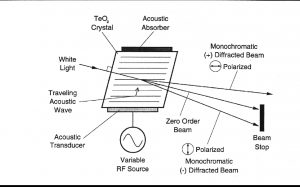
光谱的近红外范围从800nm到2500 nm延伸。在这个区域最突出的吸收谱带归因于中红外区域的基频振动的泛频和合频。是基态到第二激发态或第三激发态的能级跃迁。因为较高能级跃迁连续产生的概率较小,每个泛频的强度连续减弱。由于跃迁的第二或第三激发态所需的能量近似于第一级跃迁所需能量的二倍或三倍,吸收谱带产生在基频波长的一半和三分之一处。触简单的泛频以外,也产生合频。这些通常包括延伸加上一个或多个振动方式的伸缩。大量不同合频是可能的,因而近红外区域复杂,有许多谱带彼此部分叠加。
现在,NIRS被用作定量工具,它依赖化学计量学来发展校正组成的参照分析和近红外光谱的分析的关联。近红外数据的数学处理包括多元线性回归法(MLR)、主成分分析法(PCA)、主成分回归法(PCR)、偏最小二乘法(PLS)和识别分析。所有这些算法可以单独或联合使用来得到有价值组成的定性描述和定量预测。
III. Methodology
本研究使用了121个已知熔体指数和密度值的低密度聚乙烯样品,使用带旋转杯部件的Brimrose自由空间光谱仪收集光谱,对样品进行旋转,以平均出样品中的不同效应,如均匀性和颗粒大小差异。在1100nm和2300nm之间采集光谱,分辨率为2nm,每个样品收集了100次扫描,这些扫描被平均成一个频谱,每次读取的数据采集时间约为3秒。 该光谱以吸收光谱模式收集,然后处理成为第一个导数,然后,将第一个导数数据导入化学计量软件包”The Unscrambler” 和PLS1进行数据分析。
IV.Results
- Spectra
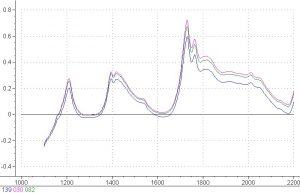
Figure 2. Absorbance spectra of some polyethylene samples.
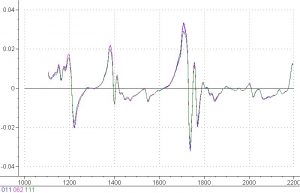
Figure 3. First derivative spectra of some polyethylene samples.
2. Regressions and Modeling

Figure 4. PLS 1 regression model for density in polyethylene samples.
This PLS 1 regression plot for density in the polyethylene samples shows excellent correlation between the measured and predicted values. The two distinct data sets in this plot are due to two different grades of material. Samples 048 and 060 are two transition samples. The data points create a good line of best fit and the correlation coefficient value of 0.985 is very high. The SEP is equal to 0.54, which proves that the model from this regression will be able to accurately predict density in polyethylene from spectral data. The SEP is well within the standard deviation target value of 6%.
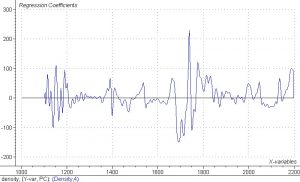
Figure 5. Regression coefficients for PLS 1 analysis of density in polyethylene samples.
The regression coefficients plot for the PLS 1 regression for density shows that most of the information for the regression comes from the wavelength regions from 1680nm to 1740nm. This area corresponds to the first overtone of the C-H stretch and is the region where one would expect to see spectral changes corresponding to changes in density. Density in polymers corresponds to changes in crystallization and this is what causes the changes in the spectral data. The fact that the first derivative data shows the greatest amount of change in the wavelength regions from 1680nm to 1740nm confirms that changes in density can be quantified using spectral data from these wavelength regions and a calibration model.
Because there was a wide range of values for melt index, it was decided to split the calibration for melt index into a low melt index calibration and a high melt index calibration.
The range of values for low melt index was from 0.7 to 2.0 and the range for low melt index was from 2.0 to 95.

Figure 6. PLS 1 regression model for low melt index in polyethylene samples. SEP is equal to 0.16 and the correlation coefficient is equal to 0.957.
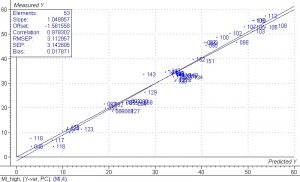
Figure 7. PLS 1 regression model for high melt index in polyethylene samples. SEP is equal to 3.14 and the correlation coefficient is equal to 0.978.
The results for these regressions show that it is quite feasible to measure melt index in polyethylene using spectral data. There was a 6% target for relative error and both the high and low melt index regressions were well within this value. One high melt index sample had an extremely high value and was left out of the calculation as an outlier.
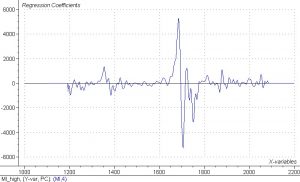
Figure 8. Regression coefficients for PLS 1 analysis of high melt flow index in polyethylene samples.
As was the case with density, the regression coefficients indicate that most of the information for the high melt flow index regression comes from the 1680nm to 1740nm wavelength range, which is the first overtone of the C-H stretch. The small amount of noise in the regression coefficients indicates that there is no overfitting of the data.
| Parameter | SEP | Correlation Coefficient |
| Density | 0.54 | 0.986 |
Low Melt Index |
0.006 | 0.982 |
High Melt Index |
3.14 | 0.978 |
Table 1. Summary of SEPs and correlation coefficients from PLS 1 regressions for density, low melt index, and high melt index in polyethylene samples.
V. Conclusions and Recommendations
This feasibility study has shown that the Brimrose Free Space spectrometer can be used to measure density and melt index in low density polyethylene. The low value of SEP and the high value of correlation coefficients are well within the standard deviation of 6%. Previous experience has shown that the use of local models in the case of melt index lowers the SEP even more. These samples were measured in the laboratory using a rotating cup assembly and in-line measurement should show even better results. Spectral rejection software developed by Brimrose will prove invaluable in this application. This software will only average spectra when there is sufficient material in front of the window and will reject spectra when the amount of material is insufficient. A self-cleaning window will ensure that enough good spectra can be taken. It is recommended that Brimrose install a spectrometer to conduct in-line tests of low density polyethylene which can be used to create a model that will allow for continuous in-line testing of polyethylene for density and melt flow index.